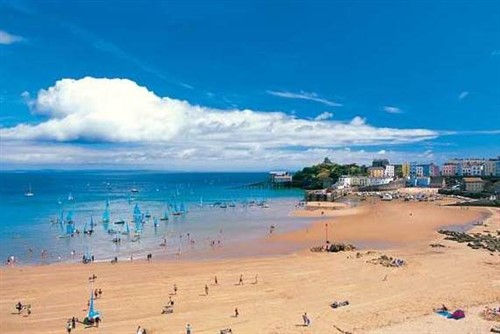From princes to plague,
civil war and presidential visits, Tenby has a depth of history
that will astonish most!
Whilst many people come to Tenby
each summer to revel in its glorious beaches and amble around its
beautiful independent shops, the town's quaint streets and medieval
walls boast a rich past that has come to play an important role in
Britain's history.
From its birth under the Norman
Conquest nearly a millennium ago through to the industrial
revolution, Tenby has its fair share of historical locations to
discover on your next visit and this piece explores some of the key
events that have shaped the town we know today.
Tenby's Norman
roots…
Founded in 1093, Tenby started its
life as a colonial outpost of the Norman dynasty - something that
would distinguish Pembrokeshire and its people from much of the
rest of the nation for centuries to come.
This Norman heritage can still be
found in the town's modern day infrastructure, with the stunning
walls that make up the perimeter of the town having initially been
built by the Norman Earls of Pembrokeshire in 1245, in a bid to
defend against opposing Welsh forces.
Tenby's walls were later fortified
by William de Valence, 1st Earl of Pembroke, after Tenby was
ransacked by the notorious Welsh Prince Llewelyn ap Gruffydd in
1260.
Whilst the town walls have been
removed or collapsed in a number of locations, the remaining walls
are Grade I listed and represent a wonderfully unique feature of
the town.
Tenby's beautiful castle was also
first built by the Normans in the same period of history, with its
elevated location making it difficult to assault and affording a
tremendous panoramic vantage point of the surrounding coastline in
anticipation of enemy forces.
Although the castle has fallen into
disrepair over its lifetime, in part due to it being successfully
captured by Welsh princes on a succession of occasions over the
12th Century, it still remains an iconic part of
Tenby's enduring appeal and a reminder of its monarchical
history.
The Prince's escape…
Tenby's unique role in the War of the Roses
As with much of Pembrokeshire,
Tenby played a key role within the War of the Roses and boasts some
fascinating links to the Tudor dynasty.
In 1457, Jasper Tudor, uncle to
Henry Tudor, invested heavily in the refurbishment of the town and
its defence structures as a result of its economic significance to
the region.
The extent to which the town was
once considered to be an important port is exemplified by the
development of the "Five Arches" tower, which stands to this day
and was built amidst fears of assault from the Spanish Armada.
The tower is understood to have
been built in the mid-16thCentury and is now a popular attraction
within the town.
Perhaps the most interesting fact
from this significant part of the town's history is the successful
escape of Henry Tudor to Brittany in 1471.
Just 14-years-old, the future king
was forced to hide in a damp underground chamber (
beneath what is now Boots!) as the war raged, before fleeing to
the continent.
Tenby's demise and the
re-emergence as a cornerstone of British tourism
Despite its importance in the Tudor
period of British history, Tenby faced a brutal demise in
importance during the mid-17th Century when a
series of bloody battles during the English Civil War saw Oliver
Cromwell's forces seize the town in 1648 - before the plague then
ravaged its population in 1650.
The industrial revolution saw Tenby
development as a tourist location, thanks to its popularisation as
a spa town by Sir William Paxton in the Victorian Era, with workers
in the major cities utilising the fresh coastal air of
Pembrokeshire as a welcome escape from the busy and often
unsanitary conditions they lived in.
The birth of Tenby as a tourism
destination of choice has lasted through to the modern day, with
thousands of people escaping to the town annually to enjoy their
holidays.
The Georgian and Victorian tourism
boons that saw Tenby establish itself as a firm favourite amongst
British holidaymakers is reflected by the number of grandiose
townhouses that offer breath-taking views of the county's coastline
and have become synonymous with the town's charm.
Tenby's war-time exploits
Like most British towns and cities
across the 20th Century, the impact of war saw
scores of Tenby's townspeople tragically lose their lives over the
First and Second World Wars.
Tenby's South Beach was identified
as a potential landing site for glider-borne assault troops from
Nazi forces and an anti-aircraft gun was therefore installed to
protect the town from any potential invasion.
Whilst Tenby avoided the damage
that was inflicted upon other strategically significant locations
within the region by Luftwaffe bombing raids - most notably
Pembroke Dock - the beaches of Tenby were utilised as practice
grounds ahead of the D-Day landings.
The town also received a visit from
a man that would later become President of the United States during
this period of its history, with General Eisenhower visiting the
United States 110th infantry regiment at Tenby in March 1944.
A memorial commemorating the 200
residents of Tenby that were killed or left missing in the two wars
can be found on South Parade Close and is a beautiful
representation of the town's sanguine mentality amidst a time of
bleak prospects.
 Now a popular tourism destination, the
beaches of Tenby were once home to training exercises ahead of the
D-Day landings
Now a popular tourism destination, the
beaches of Tenby were once home to training exercises ahead of the
D-Day landings
We hope that you've enjoyed this
whistle stop tour to Tenby's place in the British history books and
that this guide inspires you to check out some of the town's
incredible places of historical note.